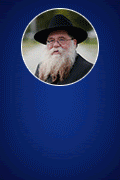
Acclaimed Physicist Bridged Religion and Science
Physicist Cyril Domb, whose advancement of theoretical physics led to new understandings of everyday phenomena, passed away last week at the age of 91. A mathematical prodigy, he also was an accomplished Talmudic scholar and authored dozens of articles on the interplay between the Torah and science, in addition to several Jewish scholarly works.
He became known for his religious convictions, earning the reputation of a model teacher whose care for his students went beyond the call of duty.
Born in London in 1920 to Yoel and Sarah Dombrowski, Domb was given the Jewish name of Yechiel. He credited his grandparents, Chaim and Frumet Wulkan, with instilling in him a “very strong religious commitment” through the examples they set in their lives and home.
From an early age, Domb excelled at mathematics and his teachers assisted his advancement in the field.
“They gave me more advanced books and so on,” he recalled, but it was a high school instructor who pushed Domb to pursue a coveted Cambridge University scholarship at the young age of 17. “I never dreamed that I would pull it off. But I did, and I went to Cambridge.”
In college, Domb encountered many challenges to his religious life. He would later credit those difficulties in shaping who he would become.
“It did me a world of good,” he said, “because it gave me confidence ever afterwards. If I got through that okay, then I could face any other challenge.”
After two years at Cambridge, Domb received first-class honors; he graduated in 1941 with an undergraduate degree in mathematics. With World War II raging across Europe and Asia, he joined the Admiralty and Signal Establishment in Portsmouth and worked on developing a way to determine the height of enemy targets from radar returns.
“I produced a set of curves from which the field strengths at any distance from a radar transmitter could readily be derived,” he detailed in a 2002 interview. “It was circulated on both sides of the Atlantic … and the curves that were featured in the report were widely used.”
As a Cambridge lecturer in 1952, he went to an interview for a professorship at Kings College in London. When the issue of his being unable to attend official functions during the Jewish Sabbath and major holidays came up, Kings College principal Peter Noble rose to his defense.
“As long as I am principal of this College,” said Noble, “there will be no religious discrimination.”
Domb received the appointment in 1954, and never encountered anti-Semitism or any form of discrimination at the school.
Three years later, he married Shirley Galinsky, with whom he raised six children.
In 1977, he was elected as a fellow of the Royal Society, and four years later, won the prestigious Max Born prize for his contributions to physics. Shortly thereafter, he moved to Jerusalem and became a professor of physics at Bar Ilan University in Tel Aviv.
Scientific Accomplishments
At Kings College, Domb placed great emphasis on placing theoretical physics at the center of his department.
“He was a pioneer in using techniques of elucidating aspects of what we call critical phenomena,” said mathematical physicist Joel Lebowitz, the George William Hill Professor of Mathematics and Physics at Rutgers University, “things which occur when the water starts boiling and turns into steam or when water freezes. He made a science of getting quantitated predictions of the behavior of such systems. [The science] tries to explaining the behavior of macroscopic objects, like water, ice or rubber tires, in terms of the properties of atoms and molecules underlying the phenomena that we observe on the microscopic level.”
In 1960, he wrote Advances in Physics, a classic in the field.
“His thesis contained the seeds of ideas on critical phenomena that have engaged a full generation of researchers, and still provide a rich lode of research ideas for future development,” stated Michael E. Fisher, professor at the University of Maryland’s Institute for Physical Science and Technology.
In 1972, together with statistical physicist Melville S. Green, he edited Phase Transitions and Critical Phenomena. After Green’s passing, he worked with Lebowitz as co-editor and by 2001, produced 20 volumes of what is considered the most authoritative series on the topic.
As both an accomplished scientist and religious Jew, Domb was often requested to lecture on science and religion. But beyond a handful of speaking engagements, he did not reach out to the many people who had questions about how the biblical narrative of creation, the existence of G‑d, and other foundational beliefs could jive with accepted scientific theories.
His reticence was challenged when the debate between George Gamow’s “Big Bang” theory of creation and the predominant “steady state” theory raged in the pages of newspapers around the world. Press reports that framed the dialogue put religious thinkers on the side of the Big Bang.
The Jewish Chronicle in London reached out to Domb and asked him to write an opinion piece of 1,000 words on the issue. In his article, he asserted that Judaism could stand alongside any one of the theories.
“This was the first time in which I engaged in public discussion” on science and religion, he would later recall.
It would not be his last.
Around that time, Domb was introduced to Chabad-Lubavitch by Rabbi Dr. Kopul Rosen, founder of Carmel College. Rosen had visited the Rebbe, Rabbi Menachem M. Schneerson, of righteous memory, in New York and taken up his suggestion to study the foundational work of Chasidic thought known as the Tanya.
Rosen shared this newfound knowledge with Domb, and when Domb had questions, Rosen told him to write to the Rebbe.
“I have never met a man who impressed me more profoundly and in whose presence I sensed a greater feeling of wisdom and utter selflessness,” Rosen wrote of the Rebbe in a letter published in a volume in his memory, which was edited by Domb.
The Rebbe told Domb that notwithstanding his vast Jewish pursuits, he should devote the time to write further about Judaism and science.
“You mention your preoccupation with other Torah projects at this time, and express the hope that you may perhaps find time on some future occasion to act on my suggestion,” the Rebbe wrote in one of several letters to the scientist. “Permit me, therefore, to observe that while the public dissemination of Torah merits a high priority, I cannot share your view that this applies to the present instance.”
The Rebbe invoked the Talmudic statement that a good deed “that cannot be performed by others takes precedence over all else.”
He immediately followed that letter with another, an atypical act that underlined the urgency. In the second letter, the Rebbe emphasized that in the present age, many Jews were rejecting Jewish teachings because of scientific questions. Those questions demanded answers.
“I was gratified and honored to receive a very detailed response from the Lubavitcher Rebbe,” Domb later expressed.
Influenced by the letters, he began spending more time working with other Jewish scientists on religious issues and wrote several articles on the subject, which were widely distributed and reprinted in many books and languages.
He later compiled and edited with Rabbi Aryeh Carmell Challenge: Torah Views on Science and Its Problems, an instant hit that was reprinted several times in its first year of publication.
Differences and Respect
It was clear from the outset that Domb and the Rebbe had different views on the validity of the theory of evolution.
“The theory of evolution has many scientific headaches and shortcomings,” Domb acknowledged. “But there is no reason why a religious Jew should not accept the theory as a current summary of biological knowledge.”
The Rebbe, however, held such a view as apologetic, stating that the biblical account of creation was literal and precluded the possibility of the world being billions of years old. Yet Domb chose to print the Rebbe’s letter on the subject as the first essay in Challenge in its section of creation and evolution, introducing the Rebbe as one who “has paid particular attention to estranged Jewish intellectuals” and had studied at the University of Berlin and the Sorbonne in Paris.
“He greatly admired the Rebbe,” Domb’s son Meir Domb revealed, “and respected his opinion.”
Although the Rebbe disagreed with Domb, he continued to encourage the scientist to write, and advocated for other scientists to submit articles for Challenge.
Domb asserted that in the 20th century, the observant Jew had an easier time living a religious life than his predecessors.
“When faced with the challenges of determinism in the 19th century, the religious scientist had to resort to faith,” he explained in one of his essays. “But the 20th century has shown that even non-religious scientists can also resort to a type of ‘faith.’ ”
He quoted Karl Popper, philosopher and professor at the London School of Economics: “The empirical basis of objective science has thus nothing ‘absolute’ about it. Science does not rest upon rock-bottom. … The old scientific ideal of absolutely certain, demonstrable knowledge has proved to be an idol.”
The physicist explained that today it is much easier to prove that there is a G‑d behind the world’s design, because “physics has provided the anthropic principle, which provides clear evidence of design, that man didn’t just emerge by chance, that the whole universe seems to have been arranged so that man could survive and emerge.”
Like the Rebbe, Domb saw great scientific theories not as absolute truth, but as extrapolated conjecture grounded in observation.
“They’re only tentative summaries of our situation,” he wrote, “whereas religion deals with what is right and what is wrong, and with many of the major driving forces in one’s life.”
Care for Others
Fisher noted that religion had a great effect on how Domb acted in his everyday life.
“He was very concerned and appreciative to look after his students,” said Fisher. “His religious conviction showed through in that way [and] had an impact with everyone he interacted with on a personal level.”
“He was both an outstanding researcher in statistical mechanics and also an outstanding human being,” said Bar Ilan physics professor Ido Kanter. “Domb’s accomplishments as a researcher are world renowned. But his honesty and forthrightness, his thoughtfulness toward others, and his high moral standards give special meaning to the term ‘humanity.’ ”
After coming home from university each day, Domb would spend much of his time engrossed in Talmudic studies. He authored a book on Jewish law and penned many articles for the Journal of Torah and Scholarship, which he launched and edited for the Bar Ilan University publishing house.
“Daddy never wasted time,” said his daughter Yocheved Debow. “He always taught us that time is the most precious gift we are given and it must be used well. We never saw him not doing something and he didn’t really need to relax.
“He walked and later swam daily for exercise,” she continued, “and otherwise was either working, writing or learning Torah.”
A short while before his passing, the prestigious Journal of Statistical Physics, published by Springer, dedicated an issue in Domb’s honor, with many papers written by his students from across the globe.
“Of course it was clear to us that his life was also centered in a spiritual and cultural way that many of us did not share,” recalled Liverpool University mathematics professor Roger G. Bowers. “This seemed to be the source of a profound inner strength and dignity.”













Might never have happened
If he were Lubavitch as a boy he would have been discourged from attending a university and he would never have accomplished his success.
his yahrzeit
He passed away chof bais Shvat.
AA
#1: he might well have achieved success in some other way. Harbeh shluchim lamakom; Hashem has many ways of accomplishing what He needs in our world.